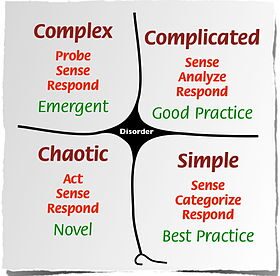
Summary of
“A Leader’s Framework for Decision Making”
Lead Article for November 2007 Volume of Harvard Business Review
Mary Boone co-authored this provocative article with David Snowden, Founder and Chief Scientific Officer, Cognitive Edge Network. Since its release, the article has received an award in 2008 from the Academy of Management and an Emerald Citation in 2011. The Emerald Citation is awarded to the top 50 articles from 15,000 articles in 300 worldwide business publications. This award is based on the number of citations over a four year period.
The Cynefin Framework
The article presents the Cynefin framework which helps leaders to understand the context for leadership decisions. The framework has 5 domains: Simple, Complicated, Complex, Chaotic, and Disorder.
Simple contexts are characterized by stability and clear cause-and-effect relationships that are easily discernible by everyone.
Complicated contexts, unlike simple ones, may contain multiple right answers, and though there is a clear relationship between cause and effect, not everyone can see it.
In a complex context, “right” answers can’t be ferreted out. Rather, patterns emerge to guide the way.
In a chaotic context, searching for right answers is pointless. The relationships between cause and effect are impossible to determine because they shift constantly and no manageable patterns exist—only turbulence.
Disorder exists when the context is unclear.
The article provides a host of examples to help illustrate these contexts and how understanding them can lead to better actions on the part of leaders.

Examples of How Leaders Deal with Complexity When Making Decisions
Today’s leaders are facing enormously complex decision-making and communication issues. In this article, we draw on the natural sciences and studies of complex adaptive systems to help leaders better handle these challenges. We also provide clear examples of how various leaders have coped with complexity.
In this video, you can see a very interesting example of how one leader in the Coast Guard was able to shift a context – he took a situation in a Chaotic Context and shifted it to a Complex Context so that it could be managed more effectively. This example is not in the article, but it beautifully illustrates the difference between a chaotic and complex context.
Ideas on How to Alter Your Communication Style to Fit a Context
Clearly, different approaches to communication are needed in different contexts. For example, in a complex context, it’s important to gather a great deal of input from a variety of sources in order to better discern the patterns that “guide the way” to a good decision. Information gathering would be quite different under the exigencies of a chaotic context. The article provides guidance on the types of communication strategies that work the best in different contexts. Some examples are as follows:
- Open up the discussion. Complex contexts require more interactive communication than any of the other domains. So, a leader might use a large group meeting or an online “Jam” session to gather input from stakeholders.
- Encourage dissent and diversity. Dissent and formal debate are valuable communication assets in complex contexts because they encourage the emergence of well-forged patterns and ideas.
- Manage starting conditions and monitor for emergence. Because outcomes are unpredictable in a complex context, leaders need to focus on creating an environment from which good things can emerge, rather than trying to bring about predetermined results and possibly missing opportunities that arise. This requires less “messaging” and more listening.

You can order the full article for $6.95 from Harvard Business Review here.